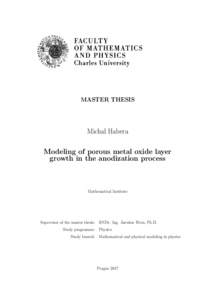Modeling of porous metal oxide layer growth in the anodization process
Modelování růstu porézních vrstev oxidů kovů v procesu anodické oxidace
diploma thesis (DEFENDED)

View/
Permanent link
http://hdl.handle.net/20.500.11956/90997Identifiers
Study Information System: 177010
CU Caralogue: 990021536720106986
Collections
- Kvalifikační práce [11349]
Author
Advisor
Consultant
Souček, Ondřej
Referee
Pavelka, Michal
Faculty / Institute
Faculty of Mathematics and Physics
Discipline
Mathematical and Computational Modelling in Physics
Department
Mathematical Institute of Charles University
Date of defense
12. 9. 2017
Publisher
Univerzita Karlova, Matematicko-fyzikální fakultaLanguage
English
Grade
Excellent
Keywords (Czech)
anodická oxidace, růst vrstvy nanotrubekKeywords (English)
anodic oxidation, growth of nanotubes layersPri vhodných podmienkach vedie anodická oxidácia k rastu komplexných poréznych štruktúr. Zrod a rast týchto štruktúr je zaujímavou a náročnou úlohou pre elektrochemické modelovanie. Je nutné identifikovať chemické reakcie vo viacfázovom systéme, odvodiť pre ne parciálne diferenciálne rovnice a riešiť ich v časovo závislých oblastiach. V tejto práci je prezentovaný elektrochemický model pre rast oxidu v nano škálach. Fyzikálne motivované rovnice sú formulované s presným matematickým významom a je skúmaná existencia riešenia. Je hľadaný elektrostatický potenciál splňujúci zákon vodivosti vo vysokých elektrických poliach a skokové podmienky na rozhraniach. Numerická diskretizácia je zavedená pomocou metódy konečných prvkov a voľné hranice sú sledované pomocou level- set metódy. Je podaný základný mechanizmus riadiaci rast poréznych štruktúr a numerické experimenty sú vysvetlené na jeho základe. Táto diplomová práca prináša nové poznatky do súčasného elektrochemického a matematického pohľadu na rast nanopórov.
Under suitable conditions anodic metal oxidation leads to growth of complex porous structures. The initiation and growth of these structures is an interesting and challenging task for electrochemical modelling. One must identify chemical reactions in a multi-phase framework, derive a proper partial differential equations and solve them in time dependent domains. In this work, electrochemical model for the oxide growth in nano scales is presented. Physically motivated equations are formulated with precise mathematical meaning and existence of solutions is studied. Electrostatic potential fulfilling high-field conduction law and interfacial jump conditions is sought for. Numerical discretization is performed with the use of finite element method and free boundaries are tracked with characteristic level-set functions. Basic mechanism governing the growth of porous structures is given and numerical experiments are explained on it's basis. This thesis presents novel contributions to the electrochemical and mathematical picture of nanopores growth.
